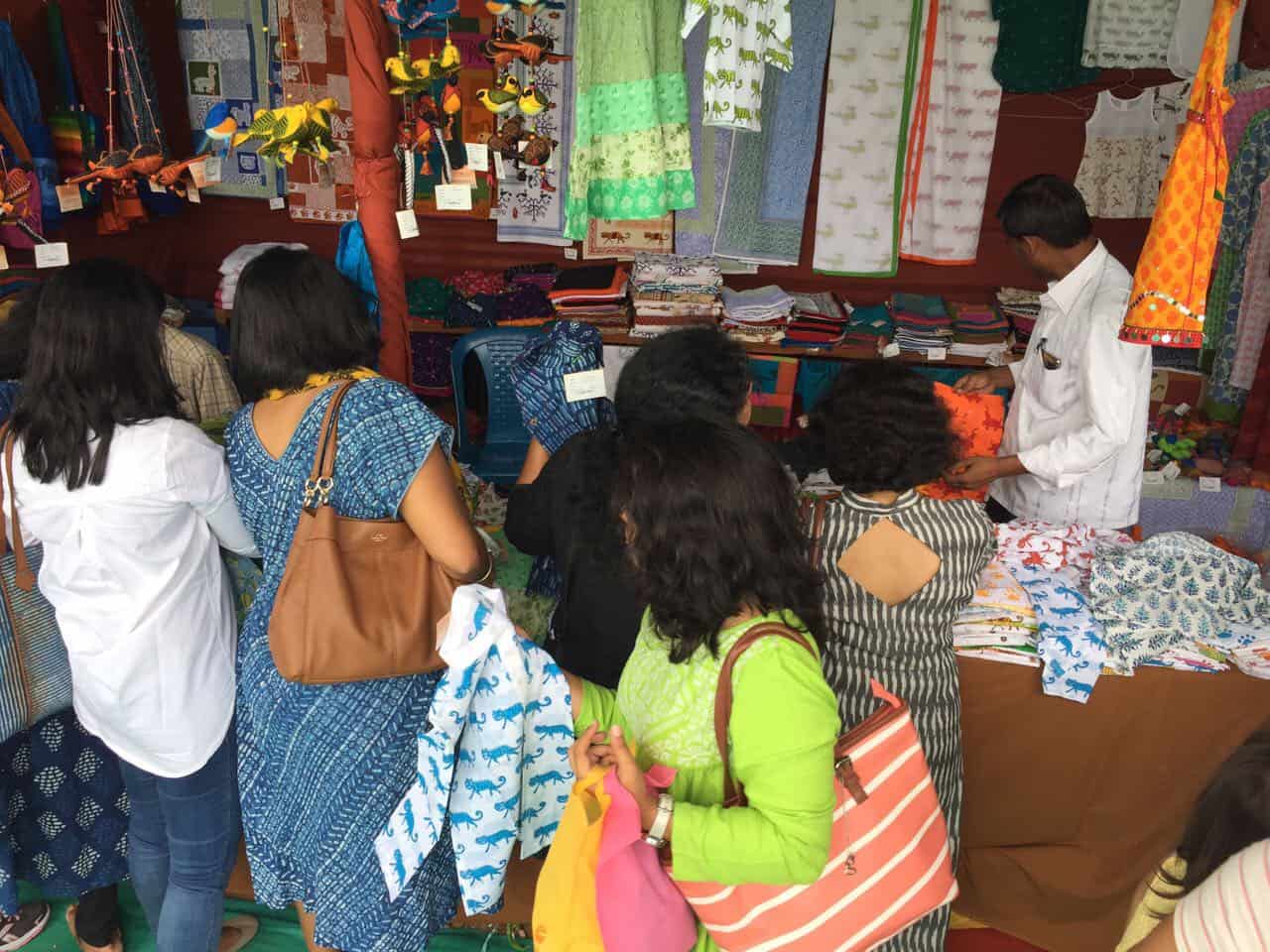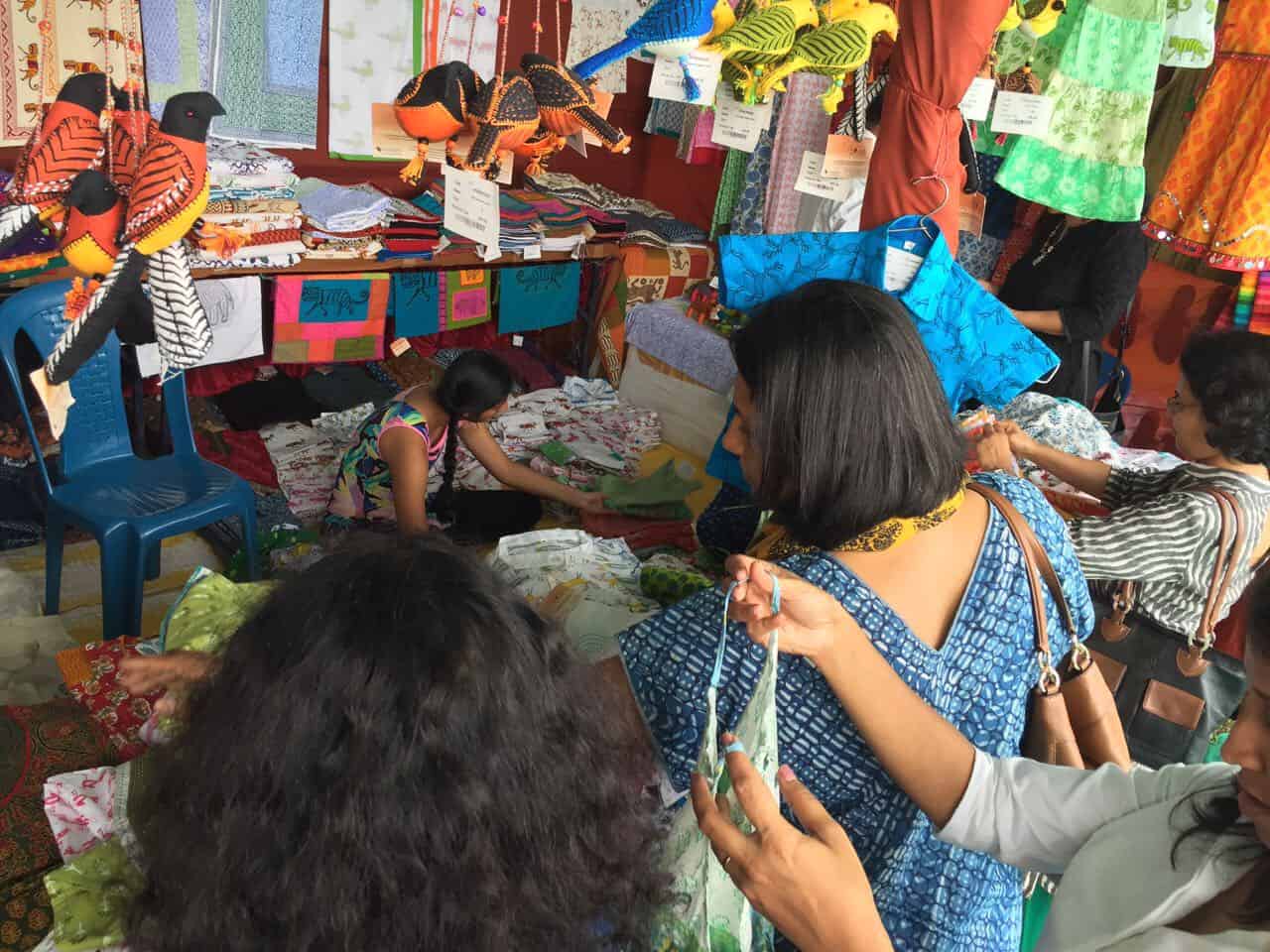I’m not quite sure why I chose to volunteer at the Dastkar Mela. There was this exhibition held between 11th and 20th August 2017, at Manpho Convention Centre, Spectrum Grounds 1 & 2, near Nagawara in Bengaluru. But nobody else I knew was volunteering, so it wasn’t as though I’d get to have a fun filled day with friends.
The only reason I can think of now, is that when I got to hear about the mela, I was relaxing after a long, tiring shopping spree at the mall. Seeing attendants busily arranging displays, putting clothes back on racks, and urging shoppers to try the next size or look at a completely different item made me curious as to what the experience was like on the other side of the counter.
We reached the site of the mela, early on a Sunday morning, after an hour long car drive that had literally taken us across Bangalore. Tiny droplets of rain clung to the fabric of my kurta and the tip of my braid; the sky was overcast and it looked like it could start pouring buckets any minute. Thick piles of sludge around the entrance didn’t really add to a good opinion of the place, but once I was inside the fairground, my view started to change. Though the grounds looked closeted from the outside, inside was a completely different story. It was quite easy to get lost within the colorful sea of people, crafts, food and general chaos.

Customers crowd around the stalls. Pic: Devika Krishnan
As I walked around the main area, the signs that had been put up by the mela management for each stall began to catch my eye. They were actually quite plain- red text on a beige background, but apart from the name of the vendors, was the state which they had come from. From Kashmir to Kerala, Maharashtra to West Bengal, there was something to offer from nearly every place. Punjabi juttis, Bengali block prints and saris from Tamil Nadu were three of the stalls I saw side by side. Though the crowd was still small, the scale of operations promised that the day would bring in a lot more.
The group I was working with was called the Ranthambore Dastkar, literally meaning the artisans from around the Ranthambore region in Rajasthan. There is a story behind every business. For the women of Ranthambore, it started when they were relocated from the forests that they lived in so that it could become a tiger reserve and National Park. Nongovernmental organisations came to Ranthambore in order to teach these women how to use their skills in block printing and sewing to make a modest income. The love for wildlife is evident- the brightly coloured, stuffed birds, made out of scrap materials, and the kurtas that have orange and yellow tiger motifs on them, stand out from the stall.
My mother’s friend, who knew several of the artisans by name, introduced me to the pair I’d be working with. They were two middle-aged men, who had also come from Rajasthan. Their weathered skin, and tough looking arms indicated someone who had spent years working outdoors. They had wide smiles as they showed me around their stall. I paused by the counter, entranced by the colorful variety of stuffed toys, and admired the bedspreads hanging out in back. Despite being on a clean white, cotton background, the design made the whole piece pop with color and vibrance.
Customers began to pour in, as expected, congregating around the periphery of the stall to admire the dohars and lehengas that hung from the rafters. Several of them saw the kurtas and fell in love with the quirky prints, requesting the size that fitted their sons and daughters.
The trouble began when they asked what size for what age as it was hard to remember which category each fell under- the sizes ranged was from 16 (for 1 year olds) to 44 (for fully grown adults). A lot of shoppers were slightly unhappy that the designs that they liked best weren’t available in their children’s size – understandable because there was a limited supply to each pattern. It was really stressful work, dealing with queries from prospective buyers, fetching new sizes of shirts and kurtas from the back of the shop, all the while being punctuated by pleas from anxious shoppers who hadn’t gotten their change back.
Another roadblock came my way once the first massive stream of shoppers left with their purchases, leaving behind a mountain of strewn clothes that didn’t make the cut. After a brief tutorial from Azadji, I was left to fold and sort through the massive bundle. And so I started, sitting hunched on the rug, carefully creasing each tiny kurta and vast shirt. Every time the pile looked like it could be taken care of, another pile of rejects was tossed on the ground for me to do.

Folding marathon Pic: Devika Krishnan
After putting the last pile of tiny frocks away in its place, I picked up my bag and headed for lunch, just across the central courtyard. Deep fried, soft yet crispy kachoris may have not been the healthiest option, but it was by far the tastiest. I sat under a tree in the shade to finish my lunch, licking my fingers, which were covered with spicy, tangy chutney.
The afternoon brought more of frenzy- it seemed like every child in Bengaluru needed a new top or soft toy. Sometimes, I’d find myself dealing with up to five different customers, each of them becoming impatient if they weren’t served first. Though some of the visitors were extremely kind and supportive, the behavior of the others made me want to cringe, and I realised the impact a few pushy people could have on a shopkeeper.
All the talking, bending and bargaining had made me extremely tired, and thirsty. I sat in the corner of the shop for a while, slowly drinking water and trying my hardest to stay out of the way. Eventually, I was pushed back into the madness, when a woman came back to the stall, furious that we had accidentally given her a wrong sized kurta. Though the issue was resolved immediately, her rudeness left me feeling both stung and shocked. Was it really OK to treat anybody like this?
Five o’clock couldn’t have come sooner, and before I knew it, I saw my mother and little brother standing outside the stall, ready to pick me up. My mother looked around the shop, admiring the variety of skirts and quilts, but my brother had eyes only for the chaat and popcorn that was being sold in the stall across ours. After everybody’s hunger was satisfied, we walked back to the Ranthambore stall, where my mother had authorised us to pick one stuffed bird each. My brother chose a green and red parrot and I, a blue- green peacock. Despite the stall’s strict no-bargaining rules, we got a ten percent discount on the two.
I said goodbye to the two shopkeepers I had worked with and gotten to know the whole day. When we reached home, I put the peacock right near the window, in a place where I could see it as soon as I woke up. Every time I look at it, I’ll be reminded of this special day and the lessons I learned from it.
Wonderful article by Sanjana, it’s so well written and articualated. I also congratulate the parents for supporting their child getting exposed to various facets of a community event like Dastkar.